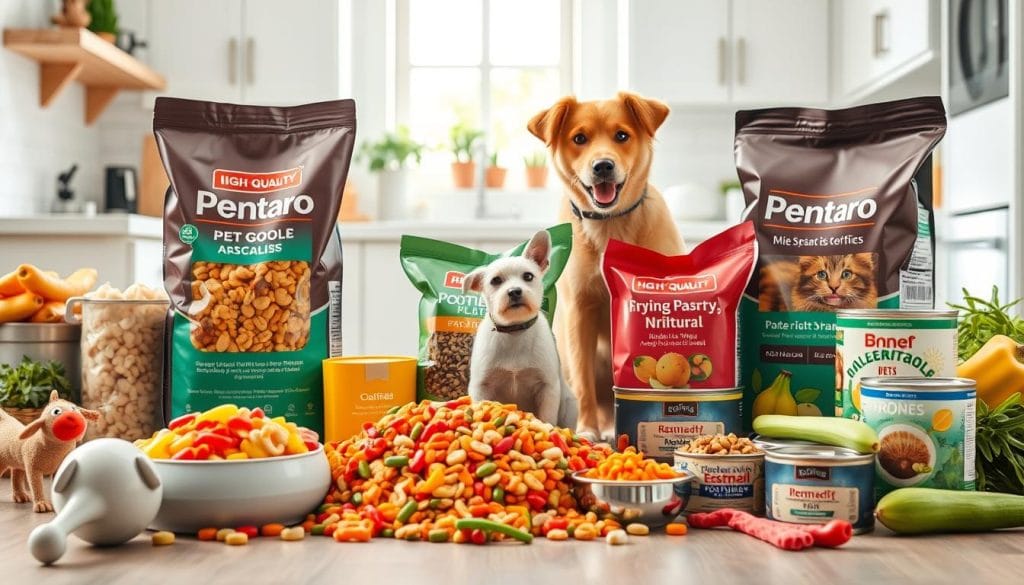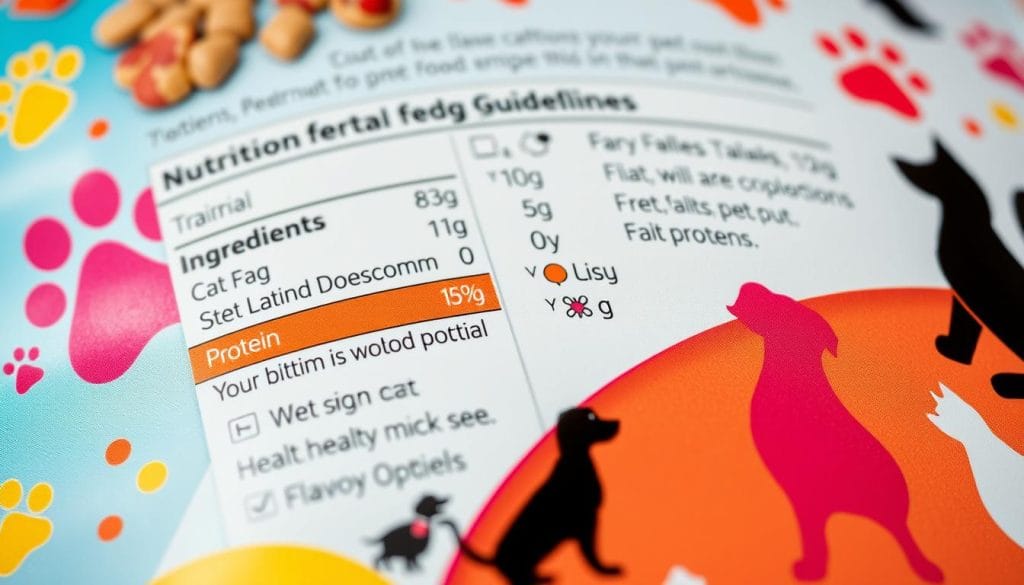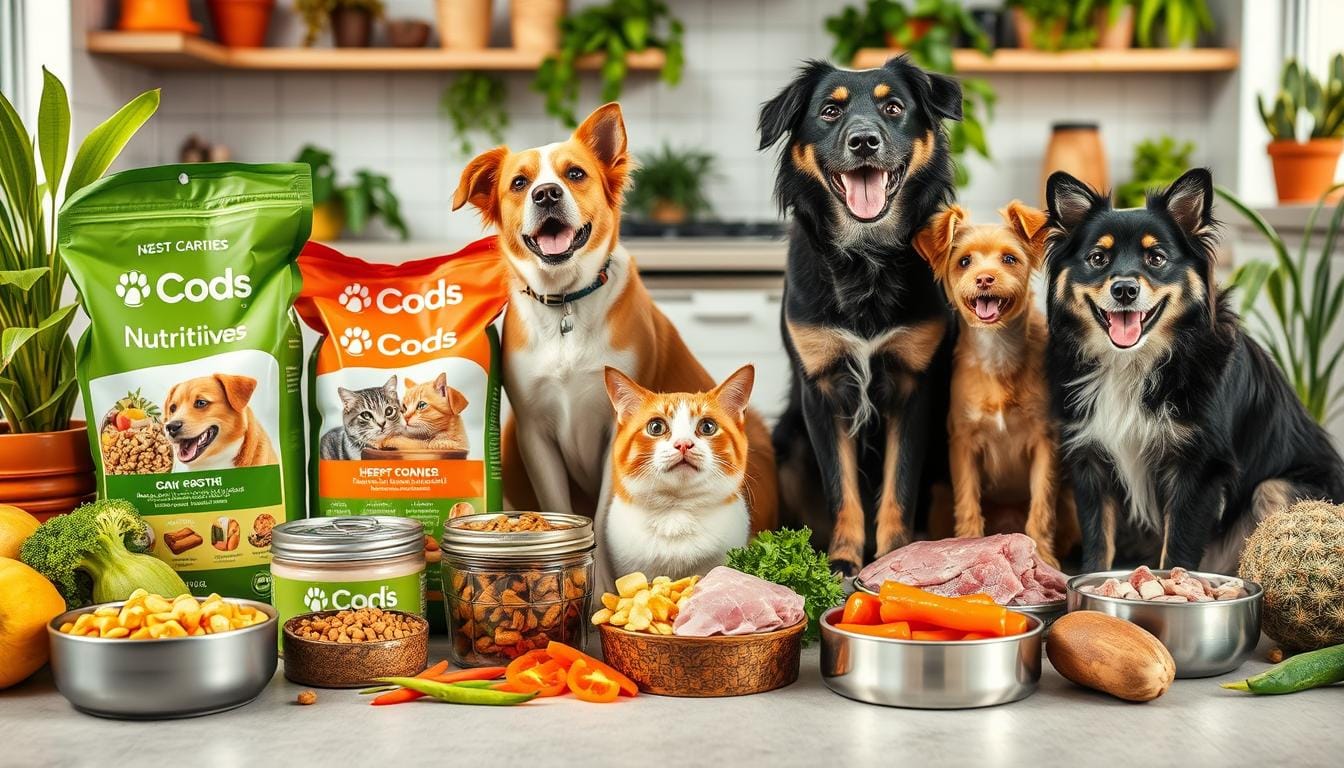Nutrition is key to your pet’s health. Good pet nutrition tips can help your pet live a long, happy life. Knowing about macronutrients, vitamins, and minerals is crucial for picking the right food.
Choosing the right pet food can be tough with so many brands and options. It’s important to know what your pet needs at different ages and understand food labels. You want to find the right mix of proteins, fats, and carbs for your pet.
Choosing a balanced diet and quality ingredients is essential for your pet’s health. Learn more about pet diet essentials to make the best choices for your pet.
Quick Recommendation: Our blog is filled with tips and information on keeping your dog healthy and happy. If you are interested in natural and holistic approaches to wellness, click here to see our #1 recommendation!
The Importance of Pet Nutrition
Your pet’s health depends a lot on good nutrition. Choosing the right food is key to a happy life. A balanced diet gives them lots of energy for fun and play.
Bad nutrition can cause health problems like weak immune systems and chronic diseases. But, a diet full of good nutrients keeps them healthy. It helps them stay at a good weight and have strong bones.
It’s important to pick high-quality food for your pet’s health. Every meal matters a lot for their daily life. It shows how what pets eat affects their health.

As pet owners, you must make sure your pet gets the best nutrition. Choosing the right food helps them live well and enjoy life more.
Recognizing Quality Pet Food Options
Choosing the right pet food can be tough with so many options. It’s important to know what makes a food high-quality. This involves looking at a few key things.
Start by checking the ingredient list. Good pet food lists a whole protein first, like chicken or fish. Stay away from foods with by-products or fillers like cornmeal or soy. These are signs of lower-quality food.
Then, think about the brand’s reputation. Brands like Blue Buffalo and Hill’s Science Diet are known for quality. Choosing a trusted brand means your pet gets nutritious food.
Reading product reviews is also helpful. Look at what other pet owners say. Their experiences can help you find good food for your pet.
Look for labels like organic, natural, and non-GMO. These mean the food has fewer artificial ingredients. Choosing these options is better for your pet’s health.
Finally, consider your pet’s specific needs. Puppies, adults, and seniors need different foods. Make sure to pick the right one for your pet’s life stage.

By looking at these factors, you can pick the best food for your pet. This ensures they get the nutrition they need.
How to Choose Pet Food for Different Life Stages
Choosing the right food for your pet is key. Nutritional needs change a lot at different life stages. Each stage needs special food to keep your pet healthy.

Puppies and kittens need lots of protein and nutrients. This helps them grow fast. Look for puppy and kitten food with DHA for brain health.
Adult pets need a balanced diet. This keeps them at a healthy weight and supports their health. Choose food that matches their size and breed.
Senior pets face health issues like joint problems. Senior food has glucosamine and fewer calories. It helps prevent weight gain and supports joint health.
Pregnant or nursing pets need extra nutrients. Special formulas with more protein, fat, and calcium are best. They help meet the needs of pregnancy and nursing.
Adjusting portion sizes and feeding times is also important. Puppies and kittens eat small meals often. Adult and senior pets do better with regular, twice-a-day meals. Knowing these needs helps keep your pet happy and healthy.
Reading Pet Food Labels
As a pet owner, it’s crucial to understand pet food labels. The details on these labels are key to your pet’s nutrition. Let’s explore the important parts you need to know.

The ingredients list is the first thing to check. Ingredients are listed by weight, from most to least. Look for whole meats or meat meals at the top.
The guaranteed analysis section is next. It shows the minimum and maximum nutrient levels. But remember, it doesn’t tell you how much your pet will eat. So, read it with other sections in mind.
Feeding instructions are also vital. They help you figure out how much food your pet needs. Adjust the portions based on your pet’s weight, age, and activity level.
Lastly, the nutritional adequacy statement is important. It tells you if the food meets AAFCO standards for nutrition. Watch out for terms like “premium” or “gourmet,” as they don’t always mean quality.
Learning to read pet nutrition labels can greatly impact your pet’s health. Always look beyond the marketing to make the best choices for your pets.
Quick Recommendation: Our blog is filled with tips and information on keeping your dog healthy and happy. If you are interested in natural and holistic approaches to wellness, click here to see our #1 recommendation!
Common Pet Nutrition Myths
There are many myths about pet nutrition. One myth is that all grain-free diets are better for pets. While some pets might do well on grain-free diets, it’s not true for everyone. Grains can provide important nutrients like fiber and vitamins.
Another myth is that pets only need one diet for their whole life. But, pets’ nutritional needs change as they grow. Puppies, adult dogs, and older pets all need different nutrients to stay healthy.
Some people think that more expensive pet food is always better. But, this isn’t always true. It’s important to look at the ingredients and nutritional facts, not just the price.
By learning the truth about pet nutrition, pet owners can give their pets the best diet. Always talk to your vet to make sure you’re making the right choices for your pet’s nutrition.
Understanding Pet Nutrition: Choosing the Right Food
Choosing the right pet food is very important. Veterinarians play a key role in this. They help decide what food is best for your pet, considering their health and nutritional needs. Getting advice from a vet helps you make a smart choice for comprehensive pet nutrition.
Things like how active your pet is, their breed, and any allergies are important. For example, active pets might need more protein. Some breeds may have health issues that require special diets. Knowing these details helps you pick the best pet food selection tips for your pet.
There are many types of pet food out there. You can choose from dry kibble, wet food, raw diets, and freeze-dried options. Each has its own good points and things to watch out for. Dry food is easy to use and helps keep teeth clean. Wet food tastes great and keeps your pet hydrated. Raw diets are more natural but need careful handling to avoid germs. Freeze-dried foods offer the best of both worlds. Thinking about these options is important for comprehensive pet nutrition and finding the right food for your pet.
By listening to veterinarians, understanding your pet’s needs, and knowing about different foods, you can make good choices. This ensures your pet gets the nutrition they need. A well-fed pet is a happy and healthy one.
DIY Pet Food: Pros and Cons
Making your own pet food is a growing trend among pet owners. It lets you control what your pet eats, ensuring they get the best ingredients. It can also save money, especially if you buy in bulk. Plus, it strengthens your bond with your pet, making mealtime special.
But, there are risks to consider before starting. Without the right knowledge, you might not provide a balanced diet. This could lead to health problems. It also takes a lot of time and effort.
It’s crucial to talk to a vet or a pet nutrition expert. They can help make sure your recipes are safe and nutritious. With the right guidance, you can enjoy the benefits of homemade pet food while avoiding the risks.
Supplementing Your Pet’s Diet
Adding supplements to your pet’s diet can help with specific health needs. It can also improve their overall well-being. Even with a balanced diet, some pets might need extra support.
For example, joint support supplements with glucosamine and chondroitin can help older pets with joint pain. Digestive aids, like probiotics, can boost gut health and nutrient absorption. If your pet has a dull coat or skin issues, there are supplements for that too. These often contain omega-3 fatty acids.
But, always talk to your vet before adding new supplements. They can help with the right dosage and suggest the best supplements for your pet. This ensures the supplements are safe and effective, helping your pet live a long and healthy life.
Conclusion
Understanding pet nutrition is key to your pet’s health and happiness. By choosing the right food, you’re showing you care about their well-being. It’s important to know how to pick the best food for their life stage and to spot trustworthy labels.
It’s also vital to debunk myths and weigh the pros and cons of homemade food. This approach helps manage your pet’s diet effectively.
Supplementing your pet’s diet can greatly benefit them. It can fill in nutritional gaps and boost their energy. This article has covered all you need to know about pet nutrition.
It’s essential to understand pet nutrition and make smart food choices. With the knowledge from this article, you can make the best decisions for your pet. Investing time in learning about their diet can significantly improve their health.
As we’ve discussed, your efforts in understanding pet nutrition are crucial. Your proactive approach to their diet is the foundation of their well-being.
Quick Recommendation: Our blog is filled with tips and information on keeping your dog healthy and happy. If you are interested in natural and holistic approaches to wellness, click here to see our #1 recommendation!

